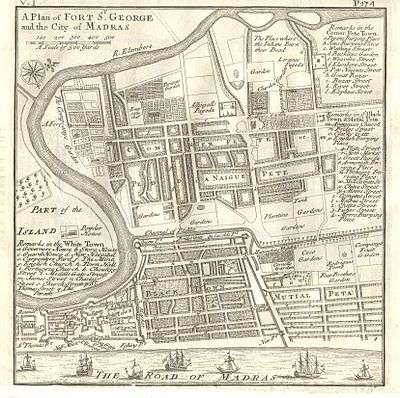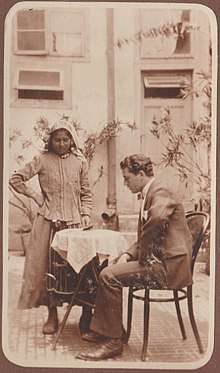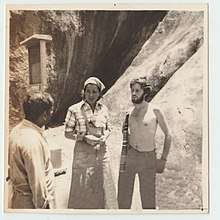Paradesi Jews
 Portrait of David Henriques De Castro, by Gabriel Haim Henriques De Castro (1838-1897) | |
| Regions with significant populations | |
|---|---|
| Israel | 70 |
| India | 5+2[1] |
| Languages | |
| Initially Ladino, later Judeo-Malayalam, Tamil, now mostly Hebrew & English | |
| Religion | |
| Orthodox Judaism | |
| Related ethnic groups | |
|
Spanish and Portuguese Jews Cochin Jews Sephardic Jews Sephardic Jews in India Luso-Indian De Castro family (Sephardi Jewish) Henriques family | |
Paradesi Jews were originally Sephardic immigrants to the Indian subcontinent from Sepharad (Spain and Portugal) during the 15th and 16th centuries who fled conversion or persecution in the wake of the Alhambra Decree expelling Jews from Spain. They are sometimes referred to as White Jews, although that usage is generally considered pejorative or discriminatory and refers to relatively recent Jewish immigrants (end of the 15th century onward), predominantly Sephardim.[2]
Paradesi Jews of Cochin traded in spices, are a community of Sephardic Jews settled among the larger Cochin Jewish community located in Kerala, a coastal southern state of India.[2]
Paradesi Jews of Madras traded in diamonds, precious stones and corals, they had very good relations with the rulers of Golkonda, they maintained trade connections to Europe, and their language skills were useful. Although the Sephardim spoke Ladino (i.e. Spanish or Judeo-Spanish), in India they learned Tamil and Judeo-Malayalam from the Malabar Jews.[3]
History



The East India Company (EIC) wanted to break the monopoly of Portugal in trading with diamonds and precious stones from the mines of Golkonda. The EIC entered India around 1600 and had built Fort St. George (White Town) fortress by 1644[4] at the coastal city of Madras, now known as Chennai.
EIC policy permitted only its shareholders to trade in diamonds and precious stones from the mines. The Company considered the Madras Jews to be interlopers because they traded separately through their Jewish community connections.[5]
Madras Jews specialised in diamonds, precious stones and corals.[6] They had very good relations with the rulers of Golkonda and this was seen as beneficial to Fort St. George, so Madras Jews were gradually accepted as honourable citizens of Fort St. George/Madras.[7]
Jacques (Jaime) de Paiva (Pavia), originally from Amsterdam, was an early Jewish arrival and a leader of the community. He established good relations with those in power and bought several mines. Through his efforts, Jews were permitted to live within Fort St. George.[8]
De Paiva died in 1687 after a visit to his mines and was buried in the Jewish cemetery which he had established in Peddanaickenpet, which later became the north Mint Street,[8] alongside the synagogue which also existed at Mint Street.[9]
In 1670, the Portuguese population in Madras numbered around 3000. Before his death he established ‘The Colony of Jewish Traders of Madraspatam’ with Antonio do Porto, Pedro Pereira and Fernando Mendes Henriques.[8] This enabled more Portuguese Jews, from Leghorn, the Caribbean, London and Amsterdam to settle in Madras. Coral Merchant Street was name after the Jews' business.[10]
Three Portuguese Jews were nominated to be aldermen of Madras Corporation.[11] Three - Bartolomeo Rodrigues, Domingo do Porto and Alvaro da Fonseca - also founded the largest trading house in Madras. The large tomb of Rodrigues, who died in Madras in 1692, became a landmark in Peddanaickenpet but was later destroyed.[12]
Samuel de Castro came to Madras from Curaçao and Salomon Franco came from Leghorn.[8][13]
Isaac Sardo Abendana (1662–1709), who came from Holland, died in Madras. He was a close friend of Thomas Pitt and may have been responsible for the fortune that Pitt amassed.[8]
Portuguese Jews were used as diplomats by the East India Company to expand English trading. Avraham Navarro was the most prominent of these.[14]
Paradesi synagogues and cemeteries
The Paradesi Jews had built three Paradesi Synagogues and Cemeteries.
In 1500 the first Paradesi synagogues and cemeteries was built in Coral Merchant Street, George Town, Madras, which had a large presence of Portuguese Jews in the seventeenth and eighteenth centuries. Neither the synagogue nor the Jewish population remains today.[15]
In 1568 Second Paradesi Synagogue and Cemetery was built in Cochin-Jew Street, the oldest synagogue in Cochin, adjacent to Mattancherry Palace, Cochin, now part of the Indian city of Ernakulam, on land given to them by the Raja of Kochi.[16]
In 1644 Third Paradesi Synagogue and Jewish Cemetery Chennai was built by Jacques (or Jaime) de Paivia in Madras, Peddanaickenpet, which later became the North end of Mint Street,[8] It was demolished by local government in 1934 and the tombstones were moved to the Central Park of Madras along with the gate of the cemetery on which Beit ha-Haim (the usual designation for a Jewish cemetery, literally "House of Life") were written in Hebrew.[17] The tombstones were moved again in 1979 to Kasimedu, when government school was approved to be built. In 1983, they were moved to Lloyds Road, when the Chennai Harbour expansion project was approved.[9] In this whole process 17 tombstones went missing, including that of Jacques (Jaime) de Paiva (Pavia).[18]
Notable Madras Paradesi Jews
- Jacques (Jaime) de Paiva (Pavia) – The first Madras Jewish community leader, he built the Paradesi Synagogue and Cemetery in Madras, Peddanaickenpet.[8][9]
- Bartolomeo Rodrigues – Among 12 aldermen who founded Madras Corporation[8]
- Domingo do Porto – Among 12 aldermen who founded Madras Corporation[8]
- Alvaro da Fonseca – Among 12 aldermen who founded Madras Corporation[8]
- Above Four were called four brothers, they had their own garden in which Bartolomeo Rodrigues Tomb was built.
- Plan of Fort St George and the city of Madras in 1726, shows Four Brothers Garden and Bartolomeo Rodrigues Tomb
- Antonio do Porto – The Colony of Jewish Traders of Madraspatam[8]
- Pedro Pereira – The Colony of Jewish Traders of Madraspatam[8]
- Fernando Mendes Henriques – The Colony of Jewish Traders of Madraspatam[8]
- Avraham Navarro – Prominent Jewish diplomats of East India Company[19]
- Samuel de Castro – Founder of De Castro Trading house.[8][13]
- Salomon Franco – Founder of De Castro Trading house.[8][13]
- Isaac Sardo Abendana – Best Diamond Appraiser[8]
Places named after Madras Paradesi Jews

- Isaac Street and Pereira Street
- This colonial street has a long history, there was a synagogue and Jewish cemetery
- Isaac Street named after Isaac Henriques De Castro who was killed in the Holocaust[20]
- Pereira Street named after Pedro Pereira- Member of, The Colony of Jewish Traders of Madraspatam[8]
- Coral Merchant Street
- Coral Merchant Street named after Jewish settlement[10]
- De Caster Main Road
- De Caster Main Road named after De Castro family (Portuguese Jew)[21]
See also
- Gathering of Israel
- History of the Jews in India
- Meshuchrarim Jews of Cochin
References
Notes
Citations
- ↑ Census of India 2001
- 1 2 Yisra'el, Muzeon (1995). Slapak, Orpa, ed. The Jews of India: A Story of Three Communities. UPNE. p. 28. ISBN 965-278-179-7. Retrieved 6 October 2018.
- ↑ Katz 2000; Koder 1973; Thomas Puthiakunnel 1973
- ↑ Roberts, J: "History of the World" (Penguin, 1994).
- ↑ Sudan, Rajani (2016). The Alchemy of Empire: Abject Materials and the Technologies of Colonialism. Oxford University Press. p. 69. ISBN 978-0-82327-067-5. Retrieved 6 October 2018.
- ↑ Gill, Liz (1 September 2011). "Chennai: Where life is enshrined". The Jewish Chronicle. Retrieved 6 October 2018.
- ↑ Muthiah, S., ed. (2008). Madras, Chennai: A 400-year Record of the First City of Modern India. 1. Palaniappa Brothers. p. 183. ISBN 978-8-18379-468-8. Retrieved 6 October 2018.
- 1 2 3 4 5 6 7 8 9 10 11 12 13 14 15 16 17 Muthiah, S. (3 September 2007). "The Portuguese Jews of Madras". The Hindu. Retrieved 6 October 2018.
- 1 2 3 Sundaram, Krithika (31 October 2012). "18th century Jewish cemetery lies in shambles, craves for attention". The New Indian Express. Retrieved 6 October 2018.
- 1 2 Muthiah, S. (30 September 2002). "Will Chennai's Jews be there?". The Hindu. Retrieved 6 October 2018.
- ↑ Muthiah, S. (2014). Madras Rediscovered. Westland. ISBN 978-9-38572-477-0. Retrieved 6 October 2018.
- ↑ Parthasarathy, Anusha (3 September 2013). "Lustre dims, legacy stays". The Hindu. Retrieved 6 October 2018.
- 1 2 3 "Chennai". International Jewish Cemetery Project. Retrieved 6 October 2018.
- ↑ Fischel, Walter J. (1956). "Abraham Navarro: Jewish Interpreter and Diplomat in the Service of the English East India Company (1682-1692)". Proceedings of the American Academy for Jewish Research. 25: 39–62. doi:10.2307/3622342. JSTOR 3622342. (Subscription required (help)).
- ↑ Muthiah, S. (2004). Lakshmi, C. S., ed. The Unhurried City: Writings on Chennai. Penguin Books India. p. 30. ISBN 9780143030263. Retrieved 6 October 2018.
- ↑ "Paradesi Synagogue". Kerala Tourism. Retrieved 6 October 2018.
- ↑ Arbell, Mordechai. "The Portuguese Jewish Community Of Madras, India, In The Seventeenth Century". Sefarad.org. Retrieved 6 October 2018.
- ↑ Sampath, Janani (10 May 2016). "Chennai's link to its Jewish past, cemetery in Mylapore fading into oblivion". DT Next. Retrieved 6 October 2018.
- ↑ Fischel, Walter J. (1956). "Abraham Navarro: Jewish Interpreter and Diplomat in the Service of the English East India Company (1682-1692)". Proceedings of the American Academy for Jewish Research. 25: 39–62. doi:10.2307/3622342. JSTOR 3622342. (Subscription required (help)).
- ↑ Parthasarathy, N.S. "The last family of Pardesi Jews in Madras". Retrieved 6 October 2018.
- ↑ "Our Readers Write". Retrieved 6 October 2018.
Further reading
- Diamonds and Coral: Anglo-Dutch Jews and Eighteenth-Century Trade New edition by Gedalia Yogev (Author)
- Renascent Empire?: The House of Braganza and the Quest for Stability in Portuguese Monsoon Asia C.1640-1683 by Glenn Joseph Ames
- Global Trade and Commercial Networks: Eighteenth-Century Diamond Merchants By Tijl Vanneste
- Goods from the East, 1600-1800: Trading Eurasia By Felicia Gottmann, Hanna Hodacs, Chris Nierstrasz
- The Jewish Merchant-Colony in Madras (Fort St. George) during the 17th and 18th Centuries: A Contribution to the Economic and Social History of the Jews in India (Concluded) Walter J. Fischel
- The Palgrave Dictionary of Anglo-Jewish History edited by W. Rubinstein, Michael A. Jolles
- Harikrishnan, Charmy (23 November 2008). "The Last Tribe: A lament for the dying Jewry in Kerala". The Indian Express. Retrieved 6 October 2018.
External links
| Wikimedia Commons has media related to Cochin Jews. |
